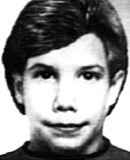Etan Kalil Patz
Etan, circa 1979; Age-progression to age 17 (circa 1989); Jose Antonio Ramos in 1988; Ramos in 2010; Pedro Hernandez in 2012
- Missing Since 05/25/1979
- Missing From Manhattan, New York
- Classification Non-Family Abduction
- Sex Male
- Race White
- Date of Birth 10/09/1972 (53)
- Age 6 years old
- Height and Weight 3'4, 50 pounds
- Clothing/Jewelry Description A black "Future Flight Captain" pilot cap pulled low over his eyes, a blue wide-wale corduroy jacket with the name "Jeff" sewn on the inside of it, blue pants and blue sneakers with fluorescent stripes.
- Distinguishing Characteristics White male. Blond hair, blue eyes. Etan's name is pronounced "Ay-tahn," and his last name rhymes with "gates."
Details of Disappearance
Etan was last seen walking to his school bus stop in the New York City borough of Manhattan on May 25, 1979 at approximately 8:00 a.m. His family resided in an apartment on Prince Street near West Broadway. The stop was on Prince Street and Wooster Streets, two blocks away. This was the first time Etan's parents allowed him to walk to the bus stop alone.
Etan was carrying a blue cloth bag imprinted with elephants and one dollar for a soft drink at the time of his disappearance. His mother watched him out the window until he crossed Wooster Street, 150 yards from the bus stop. He has never been heard from again.
Etan's bus arrived at the stop at 8:10 a.m. as usual and picked up a number of children, but Etan was not among the group. Etan's first-grade teacher at Independence Plaza School realized he was absent but did not report it to the principal, so Etan's parents did not realize he was missing until he failed to come home at 3:15 p.m. that day. After checking with neighbors to see if he was with them, they notified the authorities.
A known pedophile named Jose Antonio Ramos was the prime suspect in Etan's disappearance for many years. Photographs of him are shown with this case summary. Ramos was a drifter with mental problems who was known for assaulting young boys as he crossed the United States in the 1970s. He tended to prefer boys with light hair, like Etan.
Ramos was in New York City at the time of Etan's 1979 disappearance. He also dated a woman formerly employed by the Etan family to walk the child to and from school during a school bus strike; he was suspected of stalking the woman and molesting her son before Etan vanished. Police believed Ramos may have seen Etan accompanied by the woman, therein inadvertently leading Ramos to the child.
Ramos claimed he was with a boy matching Etan's description the day the boy disappeared. He described Etan's sneakers with their distinctive fluorescent stripes.
Ramos went on to state that he introduced himself to the child by telling him he was a "friend" of the former employee, then took the boy back to his apartment and attempted to sexually assault him. But, he said, he stopped when Etan resisted his advances and put the boy on a subway bound for Washington Heights so the child could visit his aunt there. Etan has no relatives living in Washington Heights, however.
In 1983, Ramos moved to Watersmeet, Michigan with an unidentified light-haired boy, aged about thirteen or fourteen. Etan would have been about that age in 1983. Ramos left the area after he came under suspicion for molesting several boys.
Police photographed him and the boy while they were in Michigan. Later, when they examined the photographs, they noted the boy's resemblance to an age-progression of Etan and decided to track the boy down. Ramos had told people in Watersmeet that the boy's parents ran an orphanage in Columbus, Ohio.
The boy had been arrested there, so his fingerprints were on file. Police compared the prints with Etan's. They didn't match. To make absolutely sure, authorities approached the teenager and obtained a DNA sample, which conclusively ruled out the possibility that Etan and the boy were the same person.
In 1985 the focus of the investigation briefly shifted to Israel, where a magazine there ran a photograph of Etan that had been taken by his father, with the caption "Etan Ben Haim." The photo was not among those that had been handed out to the press, so police were suspicious as to its origin. However, attempts to determine the source of the photograph were in vain and the investigation centered back on Ramos.
Two of Ramos's former cellmates, working independently of each other, told authorities that Ramos made incriminating statements about Etan's disappearance and claimed that the boy's body would never be located.
Ramos allegedly said he'd been stalking Etan and knew the child's school bus route. He was sentenced to ten to twenty years in prison in Pennsylvania for molesting a boy who, like Etan, was blond. New York investigators elected not to file charges against Ramos in Etan's case in February 2002, citing a lack of evidence.
Etan was declared legally dead by a New York judge in 2001. The action allowed the Patz family to file a civil wrongful death lawsuit against Ramos, although he has never been charged in connection Etan's case. Ramos initially refused to give a deposition on the matter. In March 2003, a Manhattan Supreme Court judge ordered Ramos to answer questions under oath about what happened to Etan.
Ramos gave a statement in October 2003, claiming he was in a park with a eight- or nine-year-old boy named Jimmy whom he'd met in Washington Square Park on the day of the Etan's disappearance. Two police officers approached him with a picture of Etan at around 11:15 or 11:30 a.m. and asked if he had seen the child.
Ramos claimed that after the police left him, he took Jimmy to an apartment. He invoked his Fifth Amendment rights against self-incrimination when asked whether he sexually assaulted the child. Authorities give little credence to Ramos's story. Etan was not reported missing until the afternoon of the day he disappeared, and investigators would not have circulated his picture for some hours after that. Ramos's story about his whereabouts at the time Etan vanished has changed several times.
Ramos refused to answer many of the questions in the deposition, so the judge presiding over the lawsuit found him liable for the child's wrongful death in May 2004. The judge ordered Ramos to pay two million dollars to Etan's parents. This decision was reversed in 2016, however. Ramos is now out of prison and has apparently left the country; his last known address was in the Philippines.
A carpenter, Othniel Miller, was briefly a suspect in Etan's disappearance in the spring of 2012. Etan had helped him the day before and Miller had paid him a dollar. In April 2012, after a cadaver dog detected the scent of decomposing remains, authorities searched for Etan's body in the basement where Miller's carpentry workshop had been. An extensive dig revealed nothing. Miller has always maintained his innocence in Etan's case.
In a surprise turn of events, in May 2012, just before the 33rd anniversary of Etan's disappearance, a suspect confessed and was arrested and charged with second-degree murder.
A photo of the suspect, Pedro Hernandez, is posted below this case summary. He was 51 years old and lived in New Jersey with his wife and daughter at the time of his arrest. When Etan disappeared he was an 18-year-old stock clerk in a bodega in Etan's neighborhood.
Hernandez had made vague statements to his family as far back as 1981 about having hurt or done something bad to a child, and sometime in the 1980s he told a church group he'd killed a child, but he never went into detail and never mentioned Etan's name. After seeing news coverage of Etan's disappearance during the search for the child's body at Miller's former basement workshop, someone close to Hernandez remembered his statements and reported him to the police.
In a three-and-a-half-hour interrogation, Hernandez told investigators he lured Etan into the store by offering him a soda, took him to the basement and strangled him. He then put the body in a plastic bag and took it out with the trash. He said he had not sexually abused the child and couldn't explain why he'd committed the murder.
Hernandez's attorney stated he suffers from bipolar disorder and schizophrenia and has auditory and visual hallucinations. He also has an intellectual disability. After his arrest, he said he was suicidal and was admitted to a hospital to treat his mental health problems. He has no criminal record and had never been a suspect in Etan's case until 2012. Other people who worked in the bodega were questioned in 1979, but not Hernandez.
The first murder trial for Hernandez ended in a mistrial in 2015, after the jury was unable to reach a verdict. At his second trial, in 2017, he was convicted. However, in 2025, Herandnez's murder conviction was overturned on appeal. He was convicted of Etan's murder in 2017 and sentenced to 25 years to life in prison. However, in July 2025, the conviction was overturned; an appeals court decided the trial judge have given "clearly wrong" and "manifestly prejudicial" instructions to the jury. The prosection has stated they plan to try him again.
Etan's body has never been found. Foul play is suspected in his case due to the circumstances involved. The journalist Lisa Cohen wrote a book about his disappearance, titled After Etan; it was published in 2009.
Investigating Agency
- New York Police Department 646-610-6914
Source Information
- The National Center for Missing and Exploited Children
- Child Protection Education of America
- New York Police Department
- The New York Post
- MSNBC
- Newsweek
- The New York Press
- The Crime Library
- California Attorney General's Office
- Newsday
- CBS News
- New York Daily News
- After Etan
- New York Magazine
- After Etan: The Missing Child Case that Held America Captive
- CNN
- USA Today
- The Washington Post
- The New York Times
- Reuters
Updated 9 times since October 12, 2004. Last updated November 26, 2025; details of disappearance updated.













